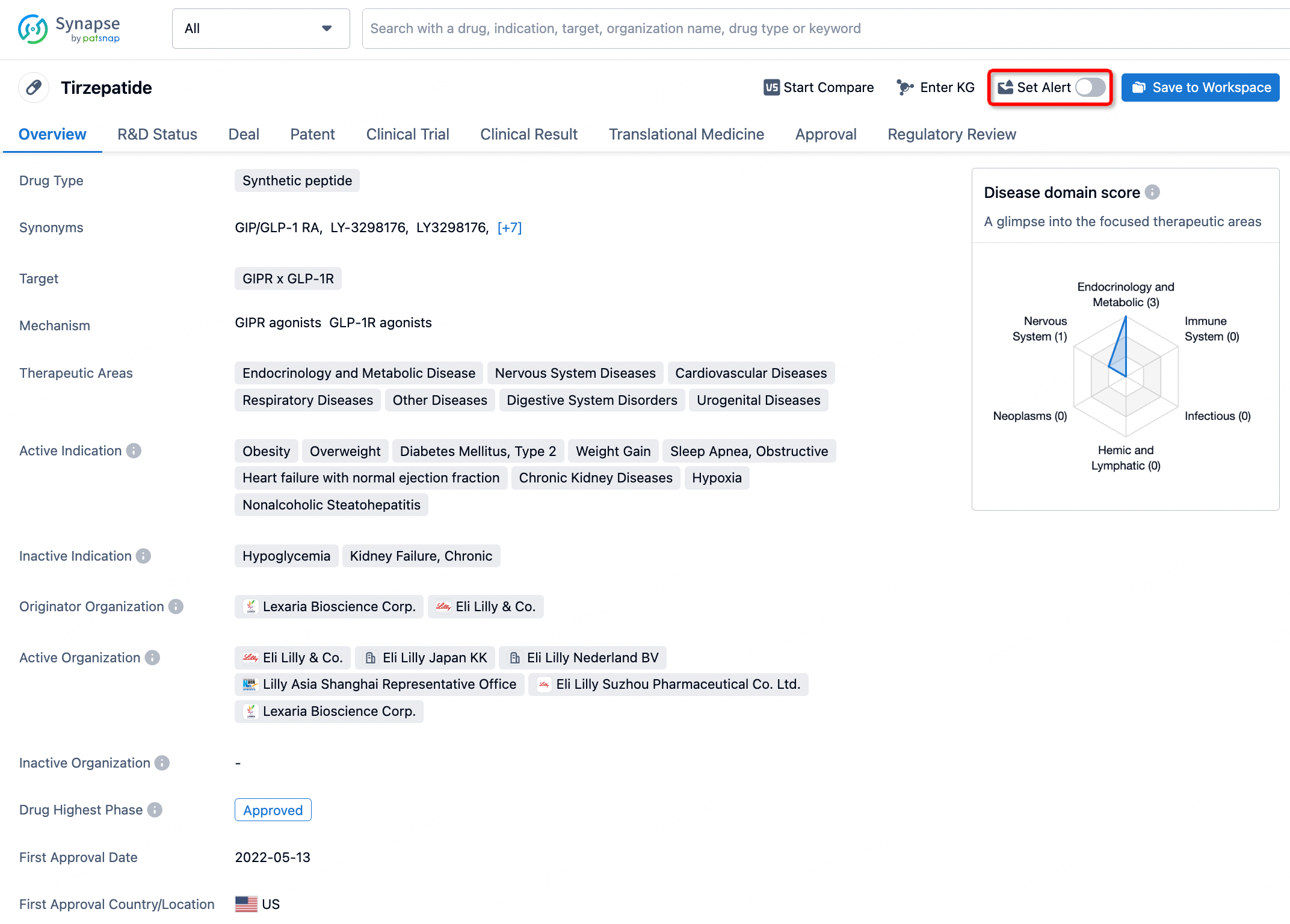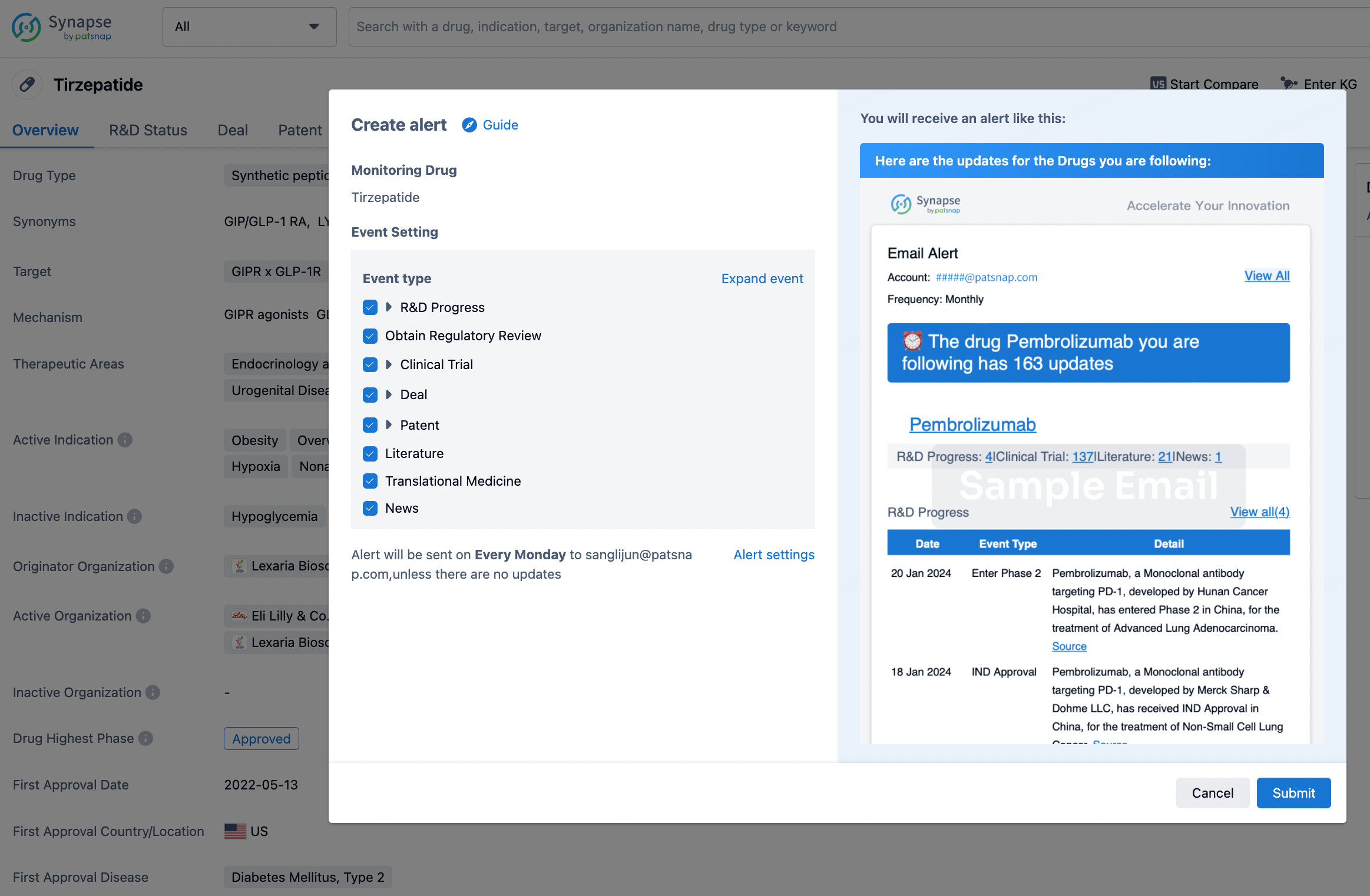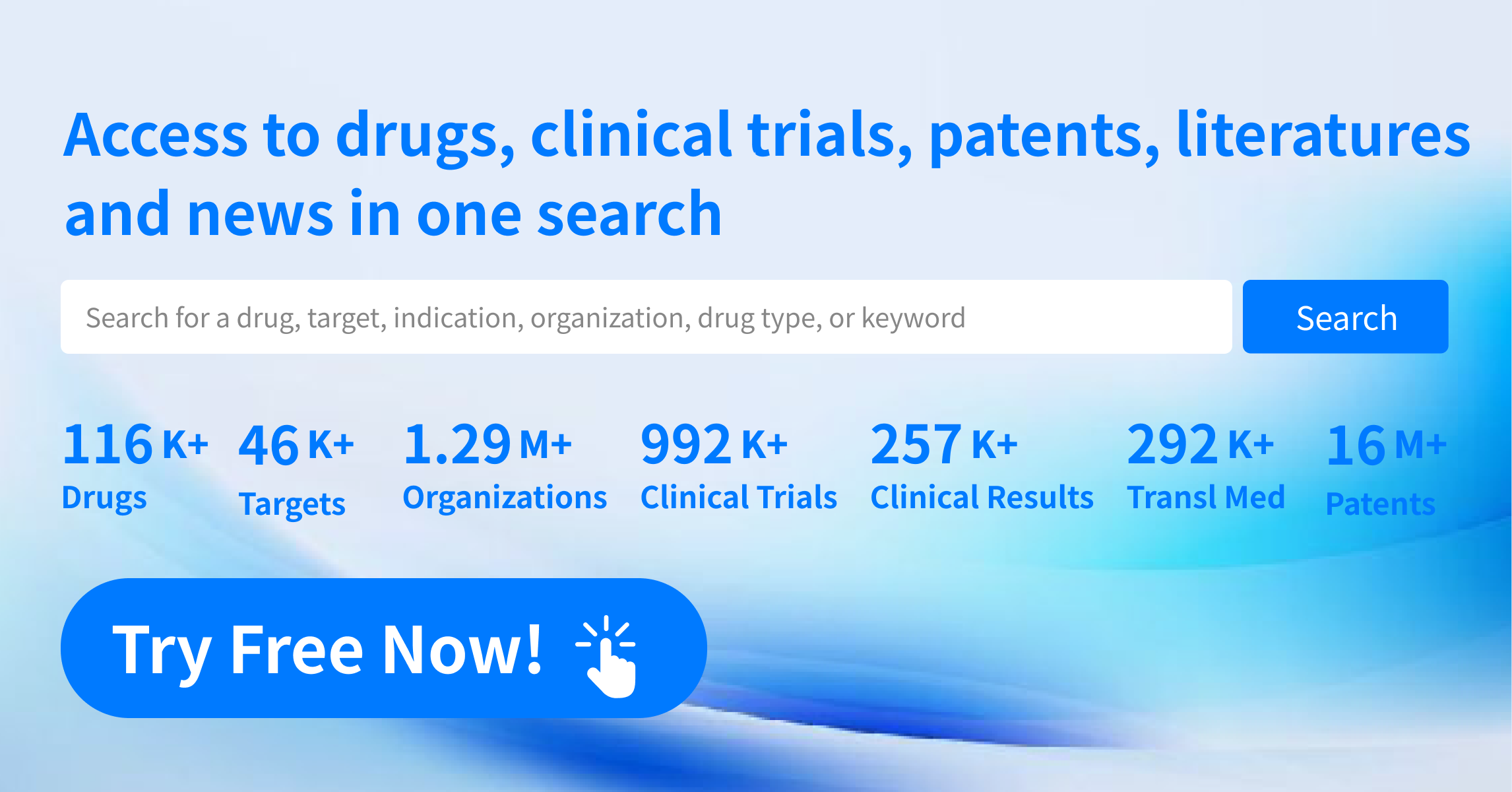Request Demo
What is Sovateltide used for?
14 June 2024
**Introduction to Sovateltide**
Sovateltide, known by its trade name PMZ-1620, is an innovative pharmacological agent currently attracting significant interest in the medical research community. This drug is a synthetic analog of the naturally occurring endothelin-1 peptide and is being developed by Pharmazz, Inc., a biotechnology company dedicated to the discovery and development of novel therapeutics for critical care and surgical indications. Sovateltide is classified as a neuroprotective and neuroregenerative agent, with its primary target being the endothelin B receptor (ETBR).
Research into Sovateltide has been primarily focused on its potential applications in treating acute ischemic stroke, cerebral ischemia, and other conditions involving severe neural injury or degeneration. Preclinical studies have shown promising results, and the drug has progressed to early-stage clinical trials to evaluate its safety and efficacy in human subjects. Due to its novel mechanism and potential to address unmet medical needs, Sovateltide has garnered attention for its prospective use in a variety of neurological conditions.
**Sovateltide Mechanism of Action**
Sovateltide operates through a distinctive mechanism involving the activation of the endothelin B receptor (ETBR), a crucial player in the regulation of vascular and neural functions. The ETBR is predominantly expressed in endothelial cells, neurons, and glial cells, where it plays a significant role in maintaining vascular tone, promoting angiogenesis, and protecting against neuronal damage.
Upon binding to ETBR, Sovateltide initiates a cascade of intracellular signaling pathways that contribute to its neuroprotective and neuroregenerative effects. One of the primary outcomes is the activation of the endothelial nitric oxide synthase (eNOS) pathway, leading to the increased production of nitric oxide (NO). Nitric oxide is a potent vasodilator that enhances blood flow, thereby improving oxygen and nutrient delivery to ischemic brain tissues. This effect is particularly beneficial in conditions such as acute ischemic stroke, where restoring blood supply to the affected area is crucial for minimizing neuronal damage.
Additionally, Sovateltide promotes the release of various growth factors, such as brain-derived neurotrophic factor (BDNF) and vascular endothelial growth factor (VEGF). These factors play essential roles in neurogenesis, synaptic plasticity, and angiogenesis, further supporting the repair and regeneration of damaged neural tissues. By bolstering these protective and regenerative processes, Sovateltide holds the potential to mitigate the long-term effects of neural injuries and improve functional outcomes for patients.
**How to Use Sovateltide**
Sovateltide is administered via intravenous (IV) infusion, which allows for rapid distribution and immediate action on the target receptors. The exact dosage and duration of treatment with Sovateltide are determined based on the specific condition being treated, the severity of the injury, and individual patient characteristics. In clinical settings, the administration of Sovateltide typically occurs in a hospital environment under the supervision of healthcare professionals.
The onset time of Sovateltide's effects is relatively quick, given the nature of IV administration. Patients can expect to experience improvements in blood flow and initial neuroprotective effects within a short period following infusion. However, the full therapeutic benefits, particularly in terms of neuroregeneration and functional recovery, may take longer to manifest and will depend on the ongoing treatment regimen and the body's response.
Clinical trials are still ongoing to refine the optimal dosing protocols and determine the precise therapeutic window for various indications. As research progresses, more detailed guidelines for the use of Sovateltide will become available, providing clinicians with a clearer understanding of how to best incorporate this drug into treatment plans.
**What is Sovateltide Side Effects**
As with any pharmacological agent, Sovateltide is associated with a range of potential side effects and contraindications that need to be carefully considered. During early clinical trials, the safety profile of Sovateltide has been closely monitored to identify any adverse reactions and ensure patient safety.
Common side effects reported in clinical studies include mild to moderate headaches, dizziness, and nausea. These symptoms are generally transient and tend to resolve on their own without the need for additional medical intervention. Some patients may also experience local reactions at the infusion site, such as redness or swelling, which are typically mild and short-lived.
More serious adverse effects are rare but can occur. These may include hypersensitivity reactions, which can manifest as rash, itching, or in severe cases, anaphylaxis. Due to the vasodilatory effects of Sovateltide, there is also a potential risk of hypotension (low blood pressure), particularly in patients with pre-existing cardiovascular conditions. Therefore, close monitoring of blood pressure and other vital signs is crucial during and after the administration of the drug.
Contraindications for the use of Sovateltide include a known hypersensitivity to the drug or its components. Additionally, caution is advised in patients with severe cardiovascular diseases, uncontrolled hypertension, or other conditions where significant changes in vascular tone could pose risks. Pregnant or breastfeeding women should also avoid using Sovateltide, as its safety in these populations has not been established.
**What Other Drugs Will Affect Sovateltide**
Drug interactions are an important consideration when administering Sovateltide, as concomitant use of certain medications could alter its efficacy or increase the risk of adverse effects. The interaction profile of Sovateltide is still being elucidated through ongoing research, but several potential interactions have been identified based on its mechanism of action and pharmacological properties.
Drugs that affect blood pressure or vascular tone, such as antihypertensives, vasodilators, or vasoconstrictors, could interact with Sovateltide. For instance, the concurrent use of other vasodilatory agents could potentiate the hypotensive effects of Sovateltide, leading to an increased risk of low blood pressure. Conversely, the use of vasoconstrictive medications may counteract the vasodilatory benefits of Sovateltide, potentially reducing its efficacy in improving blood flow to ischemic tissues.
Nonsteroidal anti-inflammatory drugs (NSAIDs) and other medications that influence renal function should also be used with caution. While specific interactions between NSAIDs and Sovateltide have not been comprehensively studied, the potential for changes in renal blood flow and function warrants careful monitoring.
Patients receiving Sovateltide should inform their healthcare providers of all medications they are currently taking, including prescription drugs, over-the-counter medications, and dietary supplements. This information will help clinicians assess potential interactions and adjust treatment plans accordingly to ensure the safe and effective use of Sovateltide.
In conclusion, Sovateltide represents a promising advance in the field of neuroprotective and neuroregenerative therapies. Its unique mechanism of action and potential applications in treating acute ischemic stroke and other neural injuries offer hope for improving patient outcomes. As research progresses, further insights into its optimal use, safety profile, and interaction potential will help pave the way for its integration into clinical practice.
Sovateltide, known by its trade name PMZ-1620, is an innovative pharmacological agent currently attracting significant interest in the medical research community. This drug is a synthetic analog of the naturally occurring endothelin-1 peptide and is being developed by Pharmazz, Inc., a biotechnology company dedicated to the discovery and development of novel therapeutics for critical care and surgical indications. Sovateltide is classified as a neuroprotective and neuroregenerative agent, with its primary target being the endothelin B receptor (ETBR).
Research into Sovateltide has been primarily focused on its potential applications in treating acute ischemic stroke, cerebral ischemia, and other conditions involving severe neural injury or degeneration. Preclinical studies have shown promising results, and the drug has progressed to early-stage clinical trials to evaluate its safety and efficacy in human subjects. Due to its novel mechanism and potential to address unmet medical needs, Sovateltide has garnered attention for its prospective use in a variety of neurological conditions.
**Sovateltide Mechanism of Action**
Sovateltide operates through a distinctive mechanism involving the activation of the endothelin B receptor (ETBR), a crucial player in the regulation of vascular and neural functions. The ETBR is predominantly expressed in endothelial cells, neurons, and glial cells, where it plays a significant role in maintaining vascular tone, promoting angiogenesis, and protecting against neuronal damage.
Upon binding to ETBR, Sovateltide initiates a cascade of intracellular signaling pathways that contribute to its neuroprotective and neuroregenerative effects. One of the primary outcomes is the activation of the endothelial nitric oxide synthase (eNOS) pathway, leading to the increased production of nitric oxide (NO). Nitric oxide is a potent vasodilator that enhances blood flow, thereby improving oxygen and nutrient delivery to ischemic brain tissues. This effect is particularly beneficial in conditions such as acute ischemic stroke, where restoring blood supply to the affected area is crucial for minimizing neuronal damage.
Additionally, Sovateltide promotes the release of various growth factors, such as brain-derived neurotrophic factor (BDNF) and vascular endothelial growth factor (VEGF). These factors play essential roles in neurogenesis, synaptic plasticity, and angiogenesis, further supporting the repair and regeneration of damaged neural tissues. By bolstering these protective and regenerative processes, Sovateltide holds the potential to mitigate the long-term effects of neural injuries and improve functional outcomes for patients.
**How to Use Sovateltide**
Sovateltide is administered via intravenous (IV) infusion, which allows for rapid distribution and immediate action on the target receptors. The exact dosage and duration of treatment with Sovateltide are determined based on the specific condition being treated, the severity of the injury, and individual patient characteristics. In clinical settings, the administration of Sovateltide typically occurs in a hospital environment under the supervision of healthcare professionals.
The onset time of Sovateltide's effects is relatively quick, given the nature of IV administration. Patients can expect to experience improvements in blood flow and initial neuroprotective effects within a short period following infusion. However, the full therapeutic benefits, particularly in terms of neuroregeneration and functional recovery, may take longer to manifest and will depend on the ongoing treatment regimen and the body's response.
Clinical trials are still ongoing to refine the optimal dosing protocols and determine the precise therapeutic window for various indications. As research progresses, more detailed guidelines for the use of Sovateltide will become available, providing clinicians with a clearer understanding of how to best incorporate this drug into treatment plans.
**What is Sovateltide Side Effects**
As with any pharmacological agent, Sovateltide is associated with a range of potential side effects and contraindications that need to be carefully considered. During early clinical trials, the safety profile of Sovateltide has been closely monitored to identify any adverse reactions and ensure patient safety.
Common side effects reported in clinical studies include mild to moderate headaches, dizziness, and nausea. These symptoms are generally transient and tend to resolve on their own without the need for additional medical intervention. Some patients may also experience local reactions at the infusion site, such as redness or swelling, which are typically mild and short-lived.
More serious adverse effects are rare but can occur. These may include hypersensitivity reactions, which can manifest as rash, itching, or in severe cases, anaphylaxis. Due to the vasodilatory effects of Sovateltide, there is also a potential risk of hypotension (low blood pressure), particularly in patients with pre-existing cardiovascular conditions. Therefore, close monitoring of blood pressure and other vital signs is crucial during and after the administration of the drug.
Contraindications for the use of Sovateltide include a known hypersensitivity to the drug or its components. Additionally, caution is advised in patients with severe cardiovascular diseases, uncontrolled hypertension, or other conditions where significant changes in vascular tone could pose risks. Pregnant or breastfeeding women should also avoid using Sovateltide, as its safety in these populations has not been established.
**What Other Drugs Will Affect Sovateltide**
Drug interactions are an important consideration when administering Sovateltide, as concomitant use of certain medications could alter its efficacy or increase the risk of adverse effects. The interaction profile of Sovateltide is still being elucidated through ongoing research, but several potential interactions have been identified based on its mechanism of action and pharmacological properties.
Drugs that affect blood pressure or vascular tone, such as antihypertensives, vasodilators, or vasoconstrictors, could interact with Sovateltide. For instance, the concurrent use of other vasodilatory agents could potentiate the hypotensive effects of Sovateltide, leading to an increased risk of low blood pressure. Conversely, the use of vasoconstrictive medications may counteract the vasodilatory benefits of Sovateltide, potentially reducing its efficacy in improving blood flow to ischemic tissues.
Nonsteroidal anti-inflammatory drugs (NSAIDs) and other medications that influence renal function should also be used with caution. While specific interactions between NSAIDs and Sovateltide have not been comprehensively studied, the potential for changes in renal blood flow and function warrants careful monitoring.
Patients receiving Sovateltide should inform their healthcare providers of all medications they are currently taking, including prescription drugs, over-the-counter medications, and dietary supplements. This information will help clinicians assess potential interactions and adjust treatment plans accordingly to ensure the safe and effective use of Sovateltide.
In conclusion, Sovateltide represents a promising advance in the field of neuroprotective and neuroregenerative therapies. Its unique mechanism of action and potential applications in treating acute ischemic stroke and other neural injuries offer hope for improving patient outcomes. As research progresses, further insights into its optimal use, safety profile, and interaction potential will help pave the way for its integration into clinical practice.
How to obtain the latest development progress of all drugs?
In the Synapse database, you can stay updated on the latest research and development advances of all drugs. This service is accessible anytime and anywhere, with updates available daily or weekly. Use the "Set Alert" function to stay informed. Click on the image below to embark on a brand new journey of drug discovery!
AI Agents Built for Biopharma Breakthroughs
Accelerate discovery. Empower decisions. Transform outcomes.
Get started for free today!
Accelerate Strategic R&D decision making with Synapse, PatSnap’s AI-powered Connected Innovation Intelligence Platform Built for Life Sciences Professionals.
Start your data trial now!
Synapse data is also accessible to external entities via APIs or data packages. Empower better decisions with the latest in pharmaceutical intelligence.


